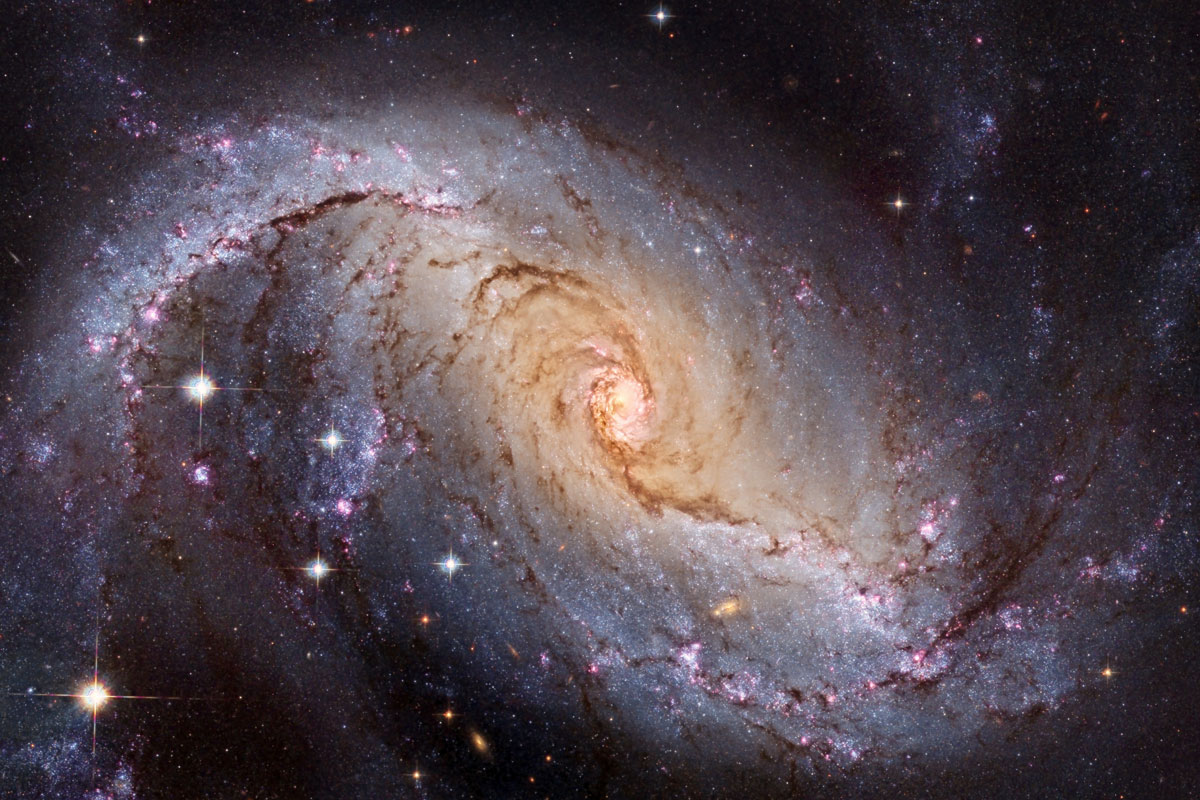Out of This Whorl
Reed physics majors show how the galaxy developed its enigmatic barred spiral.
The luminous whirlpool of the Milky Way, with its spiral arms pinwheeling from a central bar-shaped vortex, has inspired generations of scientists and stargazers alike. But the physics behind this enigmatic structure have proven surprisingly difficult to nail down. Astronomers long theorized that the force of gravity, acting on billions of stars over billions of years, would yield the spirals that characterize so many galaxies. Beginning in the 1970s, crude computer simulations produced spiral structures that lent support to the theory. Then came the realization that stars represent just a tiny fraction of the mass of the universe—most of it, in fact, consists of gas and dark matter. Does the model still hold up if you factor in that other stuff?
A team of Reed physicists, including Beckett Cummings ’20, Will Lum ’21, and Prof. Johnny Powell, decided to take up the challenge last summer, thanks in part to support from the Delord-Mockett Fund. Starting with the assumption that the galaxy began life as a gargantuan cloud of gas spanning approximately 500,000 light years, the team used a massively parallel N-body gravitational software package known as ChaNGa to carve up this cloudy colossus into 1 million sectors, each containing enough gas to fuel scores of suns, and observe what happens as they pull and push each other over the course of half a billion years.
Their first simulations failed to yield any structure whatsoever, producing nothing but big, amorphous blobs. Next they tried altering the initial configuration of matter to follow the Hernquist distribution, a model first proposed by astrophysicist Lars Hernquist in 1990. This configuration produced a flattened spheroid, which is physics-talk for a big, slightly less amorphous blob—an improvement, but still a long way from the intricate whorl of the Milky Way.
The group then borrowed an idea from Noah Muldavin ’13, who wrote his senior thesis at Reed on galactic formation using older simulation software with just 20,000 stars. While Noah’s simulation failed to yield a barred structure, it did succeed in producing spiral arms. In his thesis, Noah used a polynomial function for the initial configuration of stars:
The team faced some technical hurdles implementing the Muldavin Function on the ChaNGa system, but ironed out the bugs and eventually set up a simulation of 2 million sectors over the course of 6 billion years. ChaNGa crunched the numbers overnight and spat out its results in numerical format; the students then had to use different software to compile it into an image. “We weren’t sure if it would work,” says Beckett. “So when it popped up on the screen I almost fell off my chair. It was pure shock.”
What they saw was the elusive structure they had been hunting for—spiral arms radiating from a central bar.
“It was a really magical experience,” says Beckett. “That was the first moment when I truly felt that this was what I wanted to do with my life.”
The students grabbed the laptop and dashed up to Prof. Powell’s office to show him the blurry image on the screen. He whooped with excitement. “I’ve been waiting to see that image for five years!” he told them.
From a theoretical standpoint, this result is not particularly surprising, according to Prof. Powell. A galaxy-sized cloud of gas should be able to form a barred spiral if the initial conditions are correct. But the Reed experiment is a vivid affirmation that the model is fundamentally sound. “With these results, we can continue the process of trying to form barred galaxy of gas and stars, and start to ask more fundamental questions about the physics of bars,” he says.
Astrophysicists don’t fully understand the significance of barred spirals. One theory suggests that the bar plays a key role in concentrating mass in the center of the galaxy, spawning new stars in the process. The structure appears to be getting more common as the universe gets older; a Caltech study from 2008 estimated that barred spirals are three times more common today than they were seven billion years ago, and an Ohio State study from 1999 estimated that two-thirds of all spiral galaxies contain a bar.
The Reed project suggests that barred spirals are a transitional phenomenon, however. After several billion years, the structure collapses and the galaxy assumes a new shape.
The Delord-Mockett Fund was created by physicist Paul Mockett ’59 in honor of legendary Reed physics professor Jean Delord [1950-88], a member of the French Resistance during WWII who later became an expert in solid state, quantum mechanics, and statistical mechanics and mentored generations of Reed students.
Prof. Powell presented the Reed team’s results at the 235th meeting of the American Astronomical Society in January.
Tags: Academics, Cool Projects, Editor's Picks, Giving Back to Reed, Research
